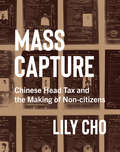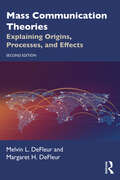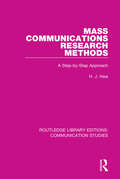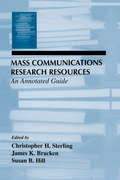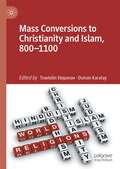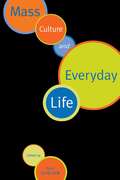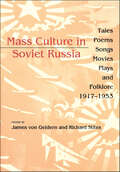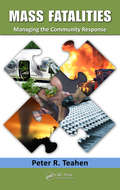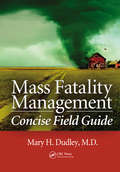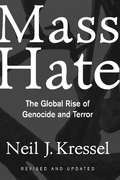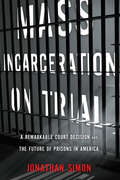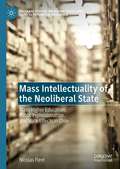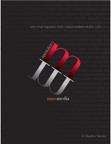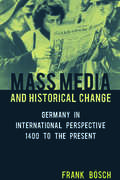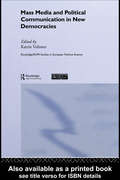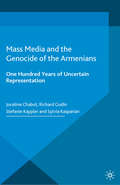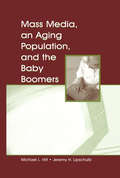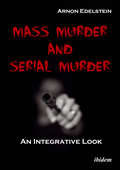- Table View
- List View
Mass Capture: Chinese Head Tax and the Making of Non-citizens
by Lily ChoUnder the terms of the Chinese Immigration Act of 1885, Canada implemented a vast protocol for acquiring detailed personal information about Chinese migrants. Among the bewildering array of state documents used in this effort were CI 9s: issued from 1885 to 1953, they included date of birth, place of residence, occupation, identifying marks, known associates, and, significantly, identification photographs. The originals were transferred to microfilm and destroyed in 1963; more than 41,000 grainy reproductions of CI 9s remain.Lily Cho explores how the CI 9s functioned as a form of surveillance and a process of mass capture that produced non-citizens, revealing the surprising dynamism of non-citizenship constantly regulated and monitored, made and remade, by an anxious state. The first mass use of identification photography in Canada, they make up the largest archive of images of Chinese migrants in the country, including people who stood no chance of being photographed otherwise. But CI 9s generated far more information than could be processed, and there is nothing straightforward about the knowledge that they purported to contain. Cho finds traces of alternate forms of kinship in the archive as well as evidence of the ways that families were separated. In attending to the particularities of these images and documents, Mass Capture uncovers the alternative story that lies in the refusals and resistances enacted by the mass captured.Illustrated with painstakingly reconstituted digital reproductions of the microfilm record, Mass Capture reclaims the CI 9s as more than documents of racist repression, suggesting the possibilities for beauty and dignity in the archive, for captivation as well as capture.
Mass Communication Theories: Explaining Origins, Processes, and Effects
by Margaret H. DeFleur Melvin L. DeFleurThe second edition of this innovative textbook provides a comprehensive overview of mass communication theories, as well as their origins and empirical supports in psychology, sociology, political science, and philosophy. Each chapter presents a specific theory, describing its basic structure in simple formal terms and providing an accessible summary of the research studies and scholarly writings from which it developed. It breaks each complex theory down into five or six interlinked basic propositions, making them easily digestible for students. This new edition includes up-to-date research; improved coverage of all theories presented; expanded treatments of theories such as cultivation theory, the spiral of silence, and framing; contemporary and social media examples; chapter discussion questions; and informative charts and figures. This textbook serves as an accessible core text for undergraduate and graduate Mass Communication, Communication Theory, and Communication and Society courses.
Mass Communication Theory: Foundations, Ferment, And Future
by Stanley J. Baran Dennis K. DavisMASS COMMUNICATION THEORY: FOUNDATIONS, FERMENT, AND FUTURE, Seventh Edition, introduces students to current and classical mass communication theories, and explains the media literacy movement in easily understood terms. Plus, this text helps students develop a better understanding of media theory so they can play a role in the media industry's future. Written in an accessible writing style, the text is designed to help increase exam performance and overall success in the course.
Mass Communications Research Methods: A Step-by-Step Approach (Routledge Library Editions: Communication Studies #7)
by H.J. HsiaOriginally published in 1988. Step-by-step, this book leads students from problem identification, through the mazes of surveys, experimentation, historical/qualitative studies, statistical analysis, and computer data processing to the final submission and publication in scientific or popular publications.
Mass Communications Research Resources: An Annotated Guide (Routledge Communication Series)
by Christopher H. Sterling Susan M. Hill James K. BrackenThis reference book is designed as a road map for researchers who need to find specific information about American mass communication as expeditiously as possible. Taking a topical approach, it integrates publications and organizations into subject-focused chapters for easy user reference. The editors define mass communication to include print journalism and electronic media and the processes by which they communicate messages to their audiences. Included are newspaper, magazine, radio, television, cable, and newer electronic media industries. Within that definition, this volume offers an indexed inventory of more than 1,400 resources on most aspects of American mass communication history, technology, economics, content, audience research, policy, and regulation. The material featured represents the carefully considered judgment of three experts -- two of them librarians -- plus four contributors from different industry venues. The primary focus is on the domestic American print and electronic media industries. Although there is no claim to a complete census of all materials on print journalism and electronic media -- what is available is now too vast for any single guide -- the most important and useful items are here. The emphasis is on material published since 1980, though useful older resources are included as well. Each chapter is designed to stand alone, providing the most important and useful resources of a primary nature -- organizations and documents as well as secondary books and reports. In addition, online resources and internet citations are included where possible.
Mass Conversions to Christianity and Islam, 800–1100
by Tsvetelin Stepanov Osman KaratayThis book explores the widespread mass conversions to Christianity and Islam that took place in Europe and Asia in the ninth to eleventh centuries. Taking a comparative perspective, contributors explore the processes at work in these conversions. Focusing on Christianity and Islam, it contrasts religious conversion in the period with earlier conversions, including those of Manichaeism in central Asia; Buddhism in east Asia; and Judaism in Khazaria, exploring why conversions to Christianity and Islam led to centralized political structures.
Mass Culture and Everyday Life
by Peter GibianMass Culture and Everyday Life is a collection of lively work from the small but seminal journal Tabloid. The book offers a clarification of the study of mass culture as it transforms daily life, providing a detailed survey of a wide range of the mass culture phenomena that have defined our everyday lives in recent years: from Hillary's hairdo to tampons, exercise fads and fashion trends; from soaps to opera to rythmn and blues; from horror movies to the interrelation of cats, pigs and mothers in Babe. This volume includes ground-breaking essays on: the boom of talk radio and talk TV; shopping as cinematic spectacle; and how "everyday life" in the university community has become a key battleground in America's "culture wars." The direct, accessible, and refreshingly personal work speak not only to an academic audience but to a wide general readership.
Mass Culture in Soviet Russia: Tales, Poems, Songs, Movies, Plays, and Folklore, 1917–1953
by James von Geldern and Richard StitesThis anthology offers a rich array of documents, short fiction, poems, songs, plays, movie scripts, comic routines, and folklore to offer a close look at the mass culture that was consumed by millions in Soviet Russia between 1917 and 1953. Both state-sponsored cultural forms and the unofficial culture that flourished beneath the surface are represented. The focus is on the entertainment genres that both shaped and reflected the social, political, and personal values of the regime and the masses. The period covered encompasses the Russian Revolution and Civil War, the mixed economy and culture of the 1920s, the tightly controlled Stalinist 1930s, the looser atmosphere of the Great Patriotic War, and the postwar era ending with the death of Stalin. Much of the material appears here in English for the first time.A companion 45-minute audio tape (ISBN 0-253-32911-6) features contemporaneous performances of fifteen popular songs of the time, with such favorites as "Bublichki," "The Blue Kerchief," and "Katyusha." Russian texts of the songs are included in the book.
Mass Culture, Popular Culture, And Social Life In The Middle East
by Georg StauthThe papers in this collection have a common theme in the question of modernity and mass culture. Two papers, those by Chaney and Featherstone respectively, discuss aspects of this theme in a general, global context, all the others are concerned more specifically with the regional context of the Middle East. All the articles in this collection were
Mass Fatalities: Managing the Community Response
by Peter R. TeahenA mass fatalities response goes far beyond returning the remains of a loved one to surviving family members. Those charged with this grim but critical responsibility will find themselves immersed in multiple tasks involving diverse individuals, organizations, and priorities. Mass Fatalities: Managing the Community Response examines multiple complex
Mass Fatality Management Concise Field Guide
by Mary H. DudleyThis student mainstay continues to be organised around constitutional themes, with new material on local elections, the politics of the centre and the limits of state power. Essential for all introductory students of British politics and current affairs.
Mass Hate: The Global Rise of Genocide and Terror
by Neil J. KresselMass Hate explores why the brutality of humankind erupted and flowed more expansively in the twentieth century than ever before. Psychologist Neil Kressel recommends specific steps to help stem this bloody global tide of slaughter, terror and genocide. In his investigation, Kressel focuses on the horrifying butchery in Rwanda, the terrifying tactics of rape and torture of women in Bosnia, the systematic murder of Jews and others during the Holocaust. He examines history, psychology, and political science for explanations of what propels a citizen to raise a machete against innocent neighbors, and, in a moving conclusion, suggests practical ways for humankind to eradicate the causes of mass hate. Now included in the preface is a discussion of the terrorist attack of September 11, 2001, on New York and the Pentagon.
Mass Imprisonment: Social Causes and Consequences
by David W Garland`The quite extraordinary phenomenon of mass imprisonment in the USA needs, above all, to be identified.' David Garland and his excellent range of criminological contributors go well beyond this by showing how to start thinking (and arguing) about what these unprecedented statistics might mean for all modern societies' - Professor Stan Cohen, Department of Sociology, LSE This major new volume of papers by leading criminologists, sociologists and historians, sets out what is known about the political and penological causes of the phenomenon of mass imprisonment. Mass imprisonment, American-style, involves the penal segregation of large numbers of the poor and minorities. Imprisonment has become a central institution for the social control of the urban poor. Other countries are now looking to the USA to see what should be learned from this massive and controversial social experiment. This book describes mass imprisonment's impact upon crime, upon the minority communities most affected, upon social policy and, more broadly upon national culture. This is a book that all penologists and policy makers should read.
Mass Incarceration in the 21st Century: Realities and Reflections
by Margaret E. Leigey Addrain Conyers Vanessa LynnThis reader presents a comprehensive review of the research on mass incarceration as it relates to causes, impact, and solutions. Assembling contributions from leading experts in a variety of disciplines as well as the voices of directly impacted people, the editors have created a diverse collection of chapters addressing prison, punishment, incarceration, reentry, and reintegration embedded in the context of the ever-evolving discussion around ending mass incarceration.The effects of the exponential prison growth in the United States over more than 50 years have been catastrophic, resulting in disparities that especially plague the poor, communities of color, and women. Mass incarceration is a culmination of policies and practices that benefit the privileged praxis and consequently disproportionally disenfranchise marginalized communities. The ideology affects every stage of the criminal justice system, from policing to release, and this book meets the need to expand the examination beyond departments of corrections to explore the administration behind laws, biased practices, and an unforgiving societal stigma. It deepens comprehension and engagement with concise and accessible readings that offer nuance and provoke thought.The book is ideal as a primary or supplementary textbook for corrections, prisons, or penology courses, as well as courses focused on law, policy, sociology, social work, and social justice. It also will serve as a valuable reference book for any individual searching for knowledge on the past, present, and future of mass incarceration.
Mass Incarceration on Trial
by Jonathan SimonFor nearly forty years the United States has been gripped by policies that have placed more than 2.5 million Americans in jails and prisons designed to hold a fraction of that number of inmates. Our prisons are not only vast and overcrowded, they are degrading--relying on racist gangs, lockdowns, and Supermax-style segregation units to maintain a tenuous order.Mass Incarceration on Trial examines a series of landmark decisions about prison conditions--culminating in Brown v. Plata, decided in May 2011 by the U.S. Supreme Court--that has opened an unexpected escape route from this trap of "tough on crime" politics. This set of rulings points toward values that could restore legitimate order to American prisons and, ultimately, lead to the demise of mass incarceration. Simon argues that much like the school segregation cases of the last century, these new cases represent a major breakthrough in jurisprudence--moving us from a hollowed-out vision of civil rights to the threshold of human rights and giving court backing for the argument that, because the conditions it creates are fundamentally cruel and unusual, mass incarceration is inherently unconstitutional.Since the publication of Michelle Alexander's The New Jim Crow, states around the country have begun to question the fundamental fairness of our criminal justice system. This book offers a provocative and brilliant reading to the end of mass incarceration.
Mass Intellectuality of the Neoliberal State: Mass Higher Education, Public Professionalism, and State Effects in Chile (Palgrave Studies on Global Policy and Critical Futures in Education)
by Nicolas FleetThis book addresses the political effects of the massification of higher education and intellectual labor in the neoliberal state. Using the case of Chile, the author argues that public professionalism emerges in the mass university system, producing excesses of knowledge which infuse the state with political purpose at many levels. The emergence of the student movement in 2011, then the major social mobilization against the neoliberal state since the restoration of democracy in 1990, provided a clear manifestation of the politicization and ideological divisions of the mass university system. In conditions of mass intellectuality, public professionals mobilize their political affinities and links with society, eventually affecting the direction of state power, even against neoliberal policy. Through several interviews with academics, public professionals, and other documentary and statistical analyses, the book illustrates the different sites of political socialization and the ideological effectiveness of the emergent mass intellectuality of the neoliberal state.
Mass Media Effects Research: Advances Through Meta-Analysis (Routledge Communication Ser.)
by Raymond W. Preiss Barbara Mae Gayle Nancy Burrell Mike Allen Jennings BryantThis distinctive collection offers a unique set of meta-analyses covering the breadth of media effects research. Editor Raymond W. Preiss and his colleagues bring together an all-star list of contributors. Organized by theories, outcomes, and mass media campaigns, the chapters included here offer important insights on what current social science re
Mass Media Law
by Clay Calvert Dan Kozlowski Derigan Silver<p>In its twentieth edition, Mass Media Law comprehensively examines the principles of media law, First Amendment freedoms of speech, and press and assembly. This timely revised edition is extremely pertinent in this era of both “fake news” and open hostility by some politicians toward the press. Students are offered an updated look at the ever-changing landscape of media law. Led by a team of preeminent scholars in the field of mass media law: Clay Calvert, Dan Kozlowski and Derigan Silver, this new edition is engaging, readable, and entertaining. <p>Instructors and students can now access their course content through the Connect digital learning platform by purchasing either standalone Connect access or a bundle of print and Connect access. McGraw-Hill Connect® is a subscription-based learning service accessible online through your personal computer or tablet. Choose this option if your instructor will require Connect to be used in the course.</p>
Mass Media Research: An Introduction
by Joseph R. Dominick Roger D. WimmerIt shows you how it happens--from content analysis to surveys to experimental research--and then equips you with expert tips on analyzing the media you encounter in your daily life. Reflecting the latest developments from the field, this popular book delivers a comprehensive overview of mass communication research and a thorough exploration of each major approach--including qualitative research, content analysis, survey research, longitudinal research, and experimental research.
Mass Media Revolution
by J. Charles SterinDebuting in its first edition Mass Media Revolution is a revolutionary learning and teaching tool designed to reflect the way students experience mass media today. With a storytelling narrative and chapter-specific videos,Mass Media Revolution helps students experience mass media, enhancing their development as critical consumers. They can study, read, interact and consume their course material in print and online in a way that best suits their individual learning needs
Mass Media and Historical Change: Germany in International Perspective, 1400 to the Present
by Frank BöschMedia influenced politics, culture, and everyday life long before the invention of the Internet. This book shows how the advent of new media has changed societies in modern history, focusing not on the specifics of technology but rather on their distribution, use, and impact. Using Germany as an example for international trends, it compares the advent of printing in Europe and East Asia, and the impact of the press on revolutions, nation building, and wars in North America and Europe. The rise of tabloids and film is discussed as an international phenomenon, as the importance of media during National Socialism is looked at in comparison with Fascist Italy and Spain. Finally, this book offers a precise analysis of media during the Cold War, with divided Germany providing the central case study.
Mass Media and Political Communication in New Democracies (Routledge/ECPR Studies in European Political Science #Vol. 42)
by Katrin VoltmerThis book examines how political communication and the mass media have played a central role in the consolidation of emerging democracies around the world. Covering a broad range of political and cultural contexts, including Eastern and Southern Europe, Latin America, Asia and Africa, this new volume investigates the problems and conflicts arising in the process of establishing an independent media and competitive politics in post-autocratic societies. Considering the changing dynamic in the relationship between political actors, the media and their audience, the authors of this volume address the following issues: changing journalistic role perceptions and journalistic quality the reasons and consequences of persisting instrumentalization of the media by political actors the role of the media in election campaigns the way in which the citizens interpret political messages and the extent to which the media influence political attitudes and electoral behaviour the role of the Internet in building a democratic public sphere This book will be of great interest to all those studying and researching democracy and democratization, comparative politics, political communication, journalism, media and the Internet.
Mass Media and the Genocide of the Armenians: One Hundred Years of Uncertain Representation (Palgrave Studies in the History of Genocide)
by Stefanie Kappler Joceline Chabot Richard Godin Sylvia KasparianThe role of the mass media in genocide is multifaceted with respect to the disclosure and flow of information. This volume investigates questions of responsibility, denial, victimisation and marginalisation through an analysis of the media representations of the Armenian genocide in different national contexts.
Mass Media, An Aging Population, and the Baby Boomers (Routledge Communication Series)
by Jeremy H. Lipschultz Michael L. HiltAs the oldest members of the baby boomer generation head into their retirement years, this demographic shift is having a substantial influence on uses of mass media, as well as the images portrayed in these media. Mass Media, An Aging Population, and the Baby Boomers provides a comprehensive examination of the relationship between media and aging issues, addressing mass media theory and practice as it relates to older Americans.Reviewing current research on communication and gerontology, authors Michael Hilt and Jeremy Lipschultz focus on aging baby boomers and their experiences with television, radio, print media, entertainment, advertising and public relations, along with the Internet and new media. They draw from studies about health and sexuality to understand views of aging, and present a view of older people as important players in the political process. Hilt and Lipschultz conclude the volume by addressing trends and making predictions related to baby boomers and mass media.Providing a timely and insightful examination of the linkage between mass media and aging issues, this volume will prove a valuable resource for scholars and students in media and gerontology. It is intended for use in coursework addressing such topics as mass communication and society, media and aging, media and public opinion, sociology, and social gerontology.
Mass Murder and Serial Murder: An Integrative Look
by Arnon EdelsteinWhile “Mass murder” refers to the murder of several people at the same time, "serial murder" describes several killings by the same perpetrator in a repetitive pattern. Usually these incidents count a high toll of victims and create significant anxiety in the public. Yet, the rate of finding murderers in these cases is relatively very low, especially in serial murders; that is if they are ever caught at all. Arnon Edelstein examines the various categories of mass murder and serial murder and suggests a new category: “mass-serial murder”. He presents and criticizes the most up-to-date research and theoretical literature in the field and suggests an integrative theoretical model. This groundbreaking volume is intended for criminologists, psychologists, sociologists, students, and readers who are interested in truly understanding the complicated aspects of this fascinating field of investigation.
